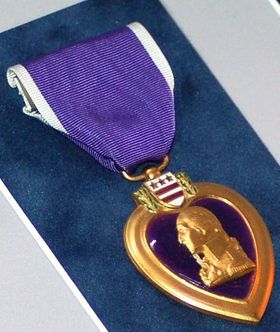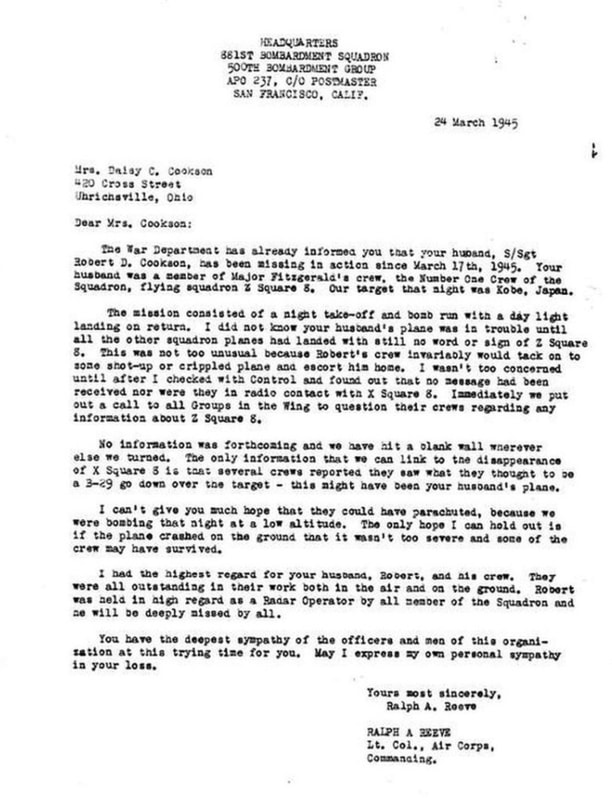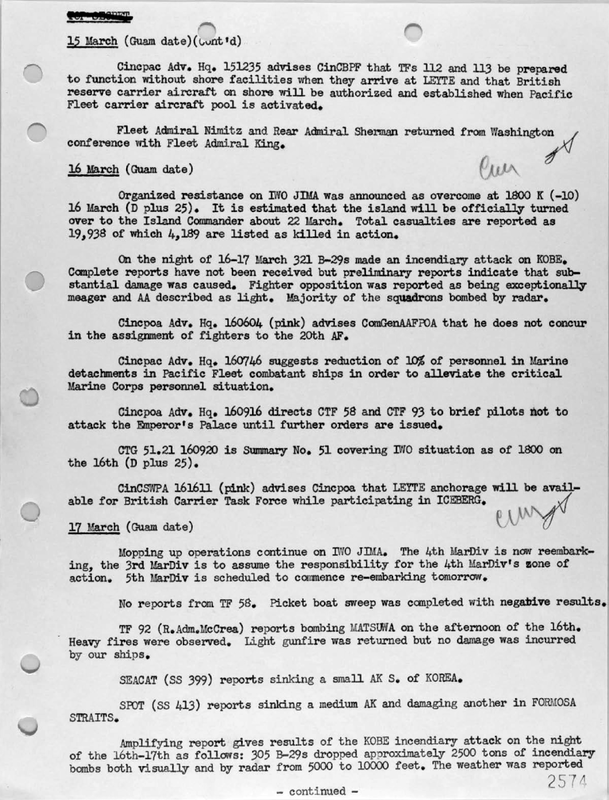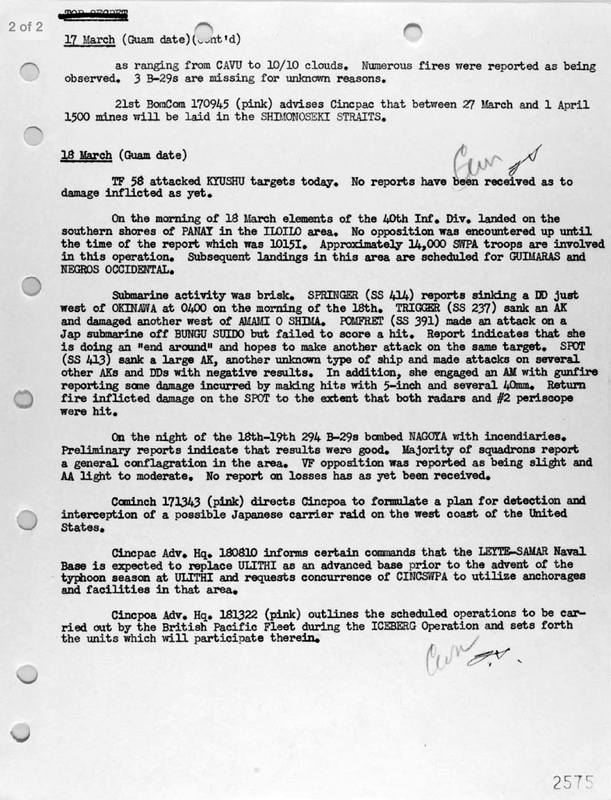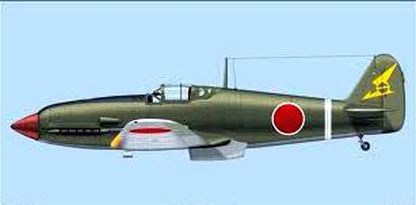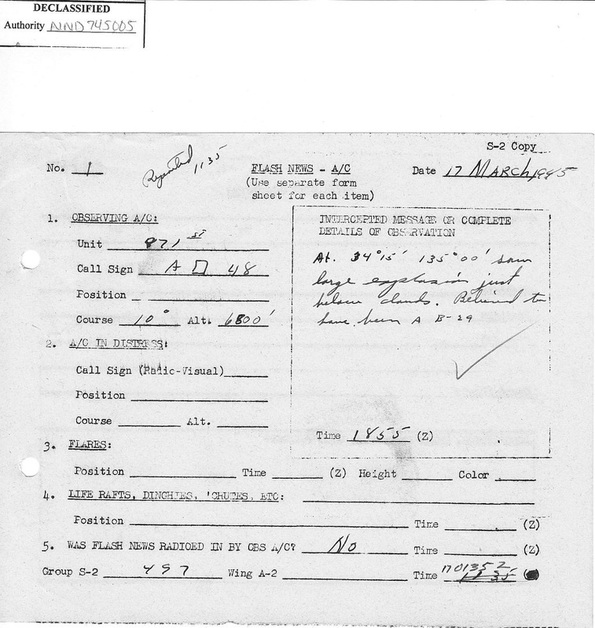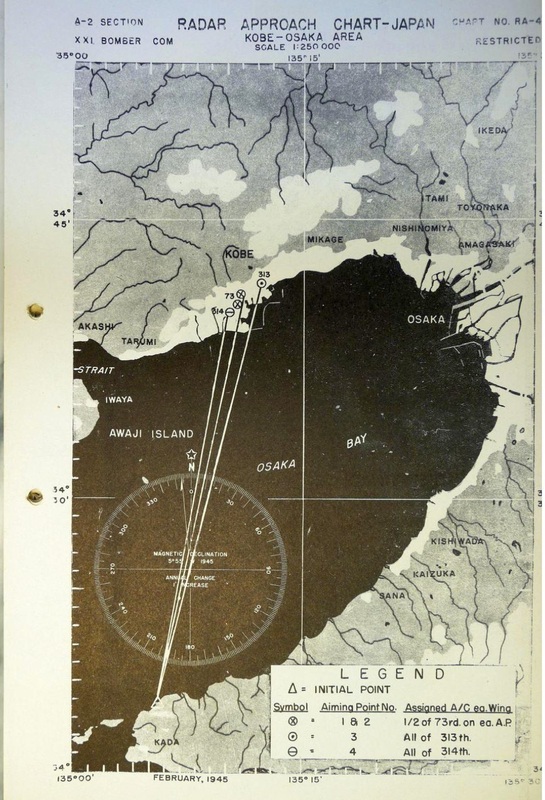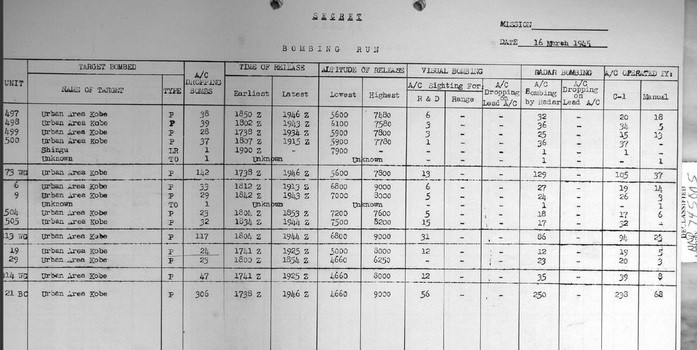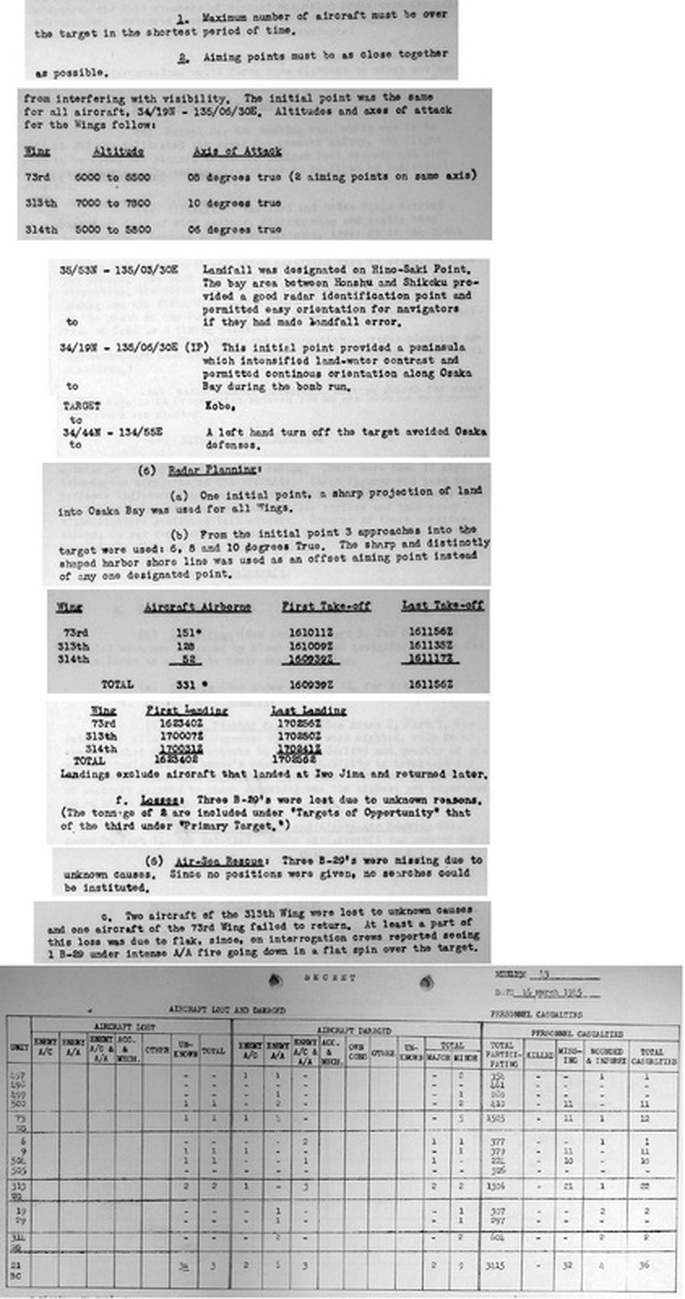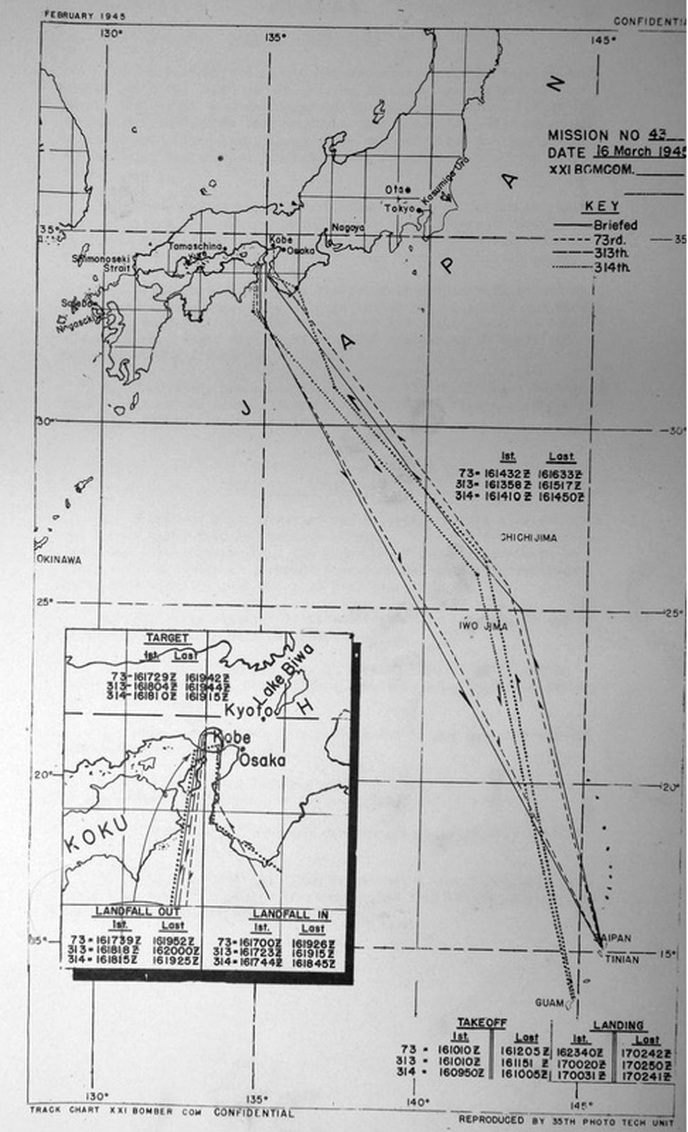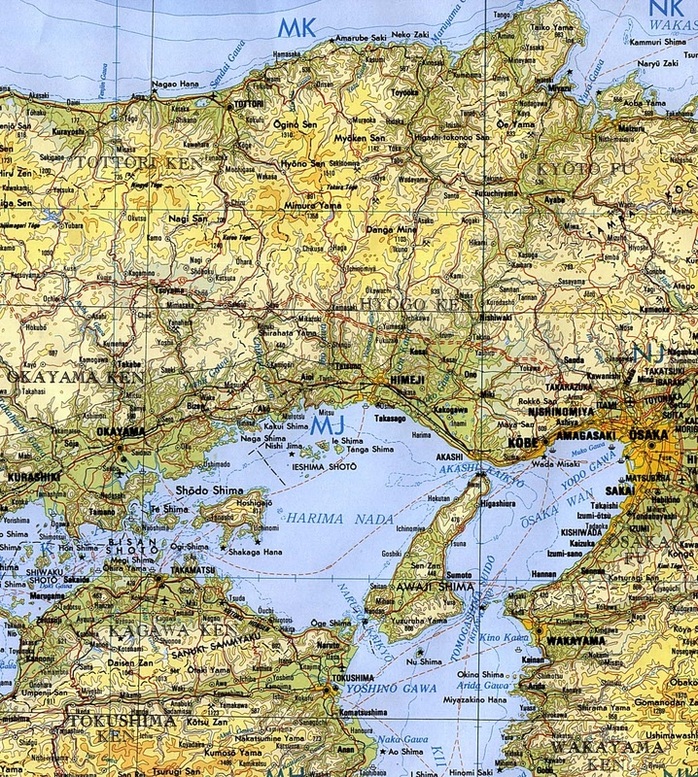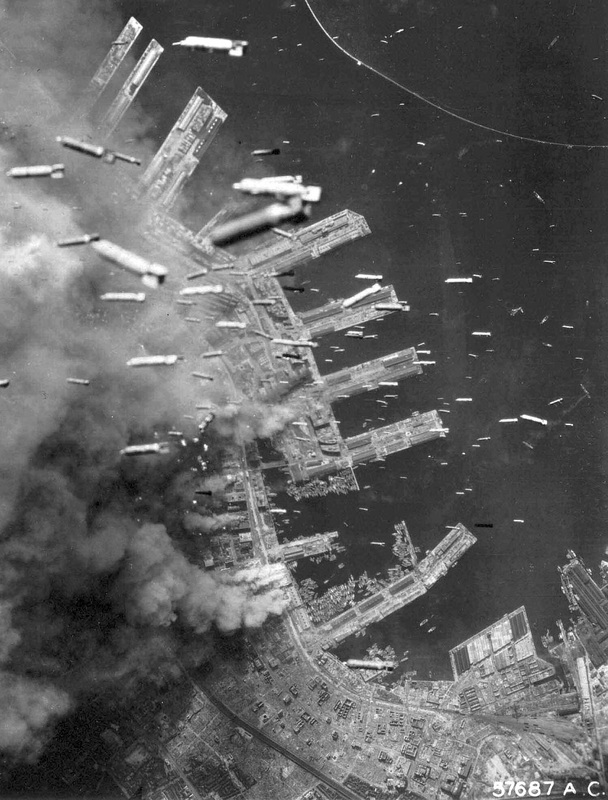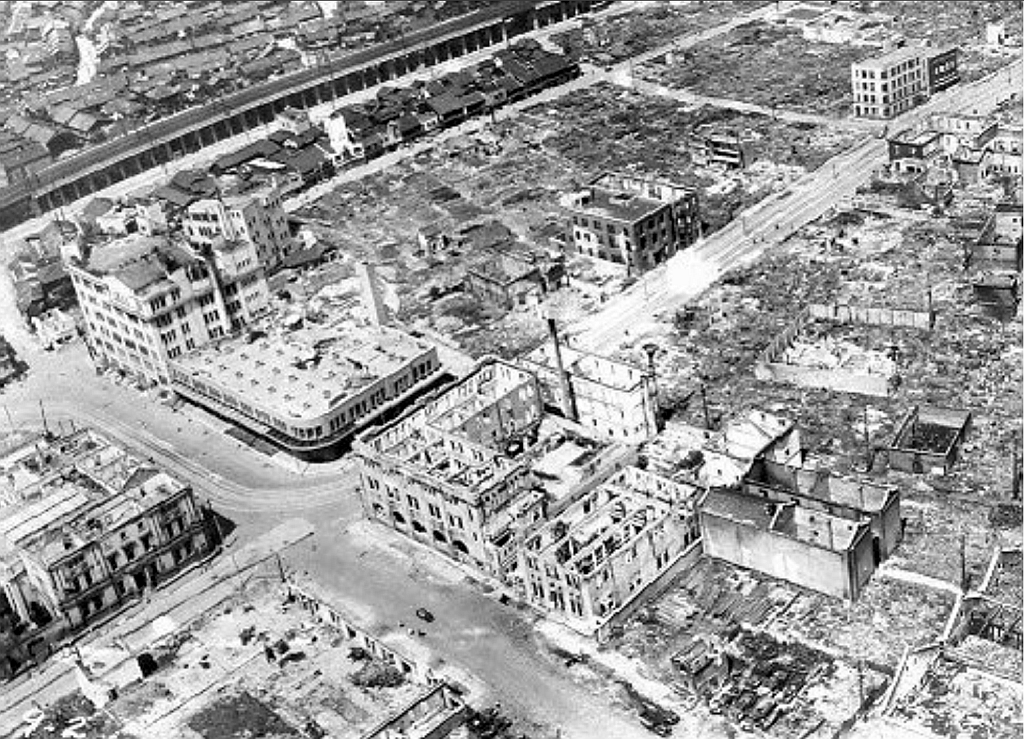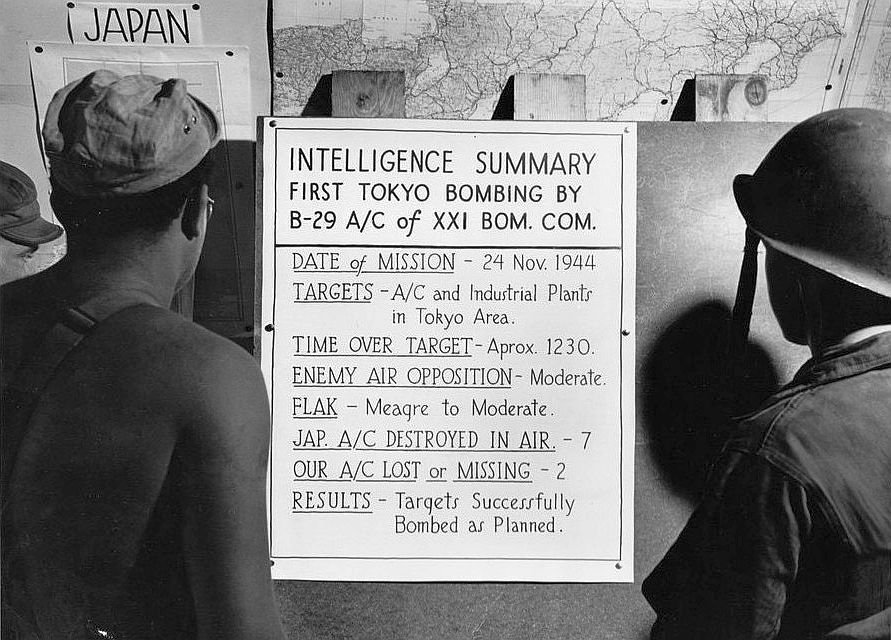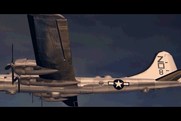
To see a simulation of the mid-air crash of Z Square 8 on 17 March 1945, click here:
http://youtu.be/ZgFUUPGbti4
"B-N-Jyu-Ku"......translated from Japanese to English means "the B-29s are our enemy."
From Kobe Historical Notes, 1945, it especially applied. Kobe was bombed by 331 B-29s on 17 March 1945, killing over 8000 residents and burning the city to black ashes. Three B-29s were downed during the bombing.
From Kobe Historical Notes, 1945, it especially applied. Kobe was bombed by 331 B-29s on 17 March 1945, killing over 8000 residents and burning the city to black ashes. Three B-29s were downed during the bombing.
The last mission...
16/17 March 1945.
Night time incendiary raid against the heavily industrialized city of Kobe, Japan. Over 300 B-29s from the Mariana Islands would participate in this raid, flying at altitudes of 5000-9000 feet.
This would be Uncle Bob's thirteenth (13Th) accredited mission. He had been on sixteen (16) missions, but the two aborted missions and the practice mission to Iwo Jima did not count toward the total needed for rotation back to the states. If nothing else he hoped that he'd get some R/R back to Hawaii so he could see his brother Rich again. The Policy of the 73rd Bomb Wing was to grant crews "rest leave" of ten days to two weeks in Hawaii after the completion of 15-20 missions over Japan. (Crews which had undergone a particularly bad experience such as a ditching or a crash-landing were given an immediate rest leave.) However, not all crews took the offer, as many wanted to complete their tours as quickly as possible.
The flights to Japan and back were long and harrowing. Over 3,000 miles round trip, and on average 13-15 hours long if everything went as planned. Damage by enemy fire or mechanical problems could extend the time even longer, as could escorting someone else's damaged B-29 back to base. Major Fitzgerald made it a point to escort other damaged aircraft back to Saipan whenever necessary, like the "Holy Joe". These trips were like working back to back, or double, shifts for workers in the states. Only for their lunch hour the B-29 aircrews didn't stop to eat, or chat, or play cards, or grab a nap.
Now, after the first seven hours of their shift, they were about to face the most hazardous part of the mission. The next hour could be deadly. The Japanese defense squadrons already knew you were coming as you neared the Eastern coast of the mainland, and they were ready for you. As you headed for, then passed over, the Initial Point (IP) and the beginning of your bomb run to Kobe, Japanese anti-aircraft artillery, "Tony" fighter planes, search-lights, and squadrons of "kamikaze" planes would seek you out and try to knock you from the sky. From the IP to the target, and from the target to 20 miles off the Japanese coast after the bomb run, you were constantly in danger of being shot down.
Your B-29, the Z Square 8, was the sixth plane in order of take off tonight, and you could feel the ship vibrate as the pilots powered up the engines. All the pre-flight checks had been done by the crew, and now it was time to go. You concentrated on your equipment as the pilots released the brakes and gave the engines more throttle and the big plane began to edge forward. The gunners watched out of the side blisters and gave the pilots the okay on the flaps being in the right position, as the flight engineer monitored his gauges. The big plane needed at least 110-120 mph to get the nose wheel up, maybe 130-140 mph to lift the plane into the air before you reached the cliff at the end of the runway. To not make lift-off with thousands of pounds of incendiary bombs in the bomb-bay would obliterate the plane and everyone on board.
The take off went smoothly, and now you could relax a little, recheck your radar equipment and concentrate on what you had to do over the next several hours. The cruising speed would probably be between 220-230 mph at low altitude. This would save precious gallons of fuel that you might need on the trip home. Everything on the ship from now on would be coordinated between all the crew members like a choreographed dance routine. A/C to Pilot to Flight-Engineer to navigator to radar operator to radio man, back and forth, calculating and recalculating, verifying and altering. Keep us on course. As radar operator, you were constantly checking terrain features looking for identifying islands, as well as wind directions and speed, bearings, distances and course. Then relaying this contact information to the navigator and pilot. On night missions you and the navigator were responsible to get the plane to the target and back, especially like this mission to Kobe. Your plane was alone all the way to the target from Saipan, and you would bomb individually.
While you were at it, maybe you'd grab a "Lucky Strike" and have a smoke, or eat a candy bar you had stashed in your pocket. Many times you and your crew members would bring along sandwiches or snacks to eat on the flight. But sometimes you couldn't eat until the bomb run was complete and you were safely away from Japan. You might have time to talk to one of the gunners in the rear pressurized compartment-Holley, Wray, Barry or Cutler. The gunners kept an eye out for any potential engine problems for the pilots. David W. Holley was in charge of the Central Fire Control (CFC) and he turned on and made sure the guns were operational. When the order was received, usually all gunners tested their guns with short bursts only. But on this flight to Kobe, only tail gunner Ruben Wray had ammunition for his gun. Probably because "night fighters" generally attacked from the rear quadrants of the bombers. Maybe the A/C would turn over the flight controls to Co-Pilot Copeland, giving him some flight hours. The bombardier would check and recheck his equipment, and maybe talk to the pilots if things were going well. The radio operator stayed glued to his set, checking his frequencies, ensuring they were in contact with Saipan, checking for Naval ships along their flight path, and listening for alerts from one of the other B-29s.
No one ever really relaxed on these flights, but the bombardier and the gunners had a lot of "slack" time on the way to Japan, and especially on the way back. But the A/C, Co-Pilot, Flight Engineer, navigator, radio operator and radar operator were kept busy through out the entire flight.
All the while you and the navigator kept coordinating your flight plan, checking altitude, wind direction and speed, drift, and keeping the big ship on course.
Flying at night, you as radar operator were constantly checking your scope for identifiable land masses to guide you toward Japan. Once you identified Iwo Jima you knew you were half way to the target. Then the Bonin Islands passed by to the right of your ship. Closer and closer the target emerged as you listened to the four Wright-Cyclone 3350 engines pulling you along. Already wearing your "Mae West," you rechecked your other equipment again. Steel helmet, "flak" jacket, parachute. You became a little tense, but there was no fear. There was no time for that.
Located approximately 240 miles WSW of Tokyo, Kobe for the first time, would be subjected to a low-level, night time, incendiary bombing attack by over 300 B-29 bombers. It's industries were intermingled efficiently within civilian neighborhoods and spread out to lesson the damage from high altitude bombing. Some were camouflaged, some were not. Japanese industry was organized with large plants relying on smaller sub-contractors scattered through-out the city. The civilian population of Kobe provided the industrial workers for all those plants and facilities, both men and women, and sometimes children. But General LeMay's new low level saturation bombing in the last week would not make a difference to the Japanese deployment of their factories tonight. Everything would be destroyed in the fire bombing.
You were off the coast of Japan now, and all available B-29s were preparing their individual bombing runs and heading from the IP to Kobe. You are on your own tonight, and you're nervous, but you concentrate on your job, which is to ensure the correct course for the bomb run. Tonight, your ship and crew members are relying on you to make a successful "radar bomb run". You have identified landmarks to help guide the navigator, bombardier and pilots to the target. You concentrate on your radar screen and your settings and have identified the wind direction and speed, distance and course, and are directing the "Mission to Albuquerque" to the target. Your entire concentration is on the "target." Only the target. You are aware of yourself talking, and you hear the voices of the navigator, pilot, and bombardier in your headset as you speed toward Kobe.
You hear the conversation between the navigator, the pilot and the bombardier. Then you hear Major Fitzgerald tell Lt. Brousek that he is turning the airplane over to him to make the bomb run. Lt. Brousek adjusts and readjusts his settings in anticipation of dropping his deadly payload on Kobe based on the "radar" information you have provided. Bomb bay doors open. Suddenly you feel a sensation as the bombs are released and you hear "bombs away" over your headset. Done. Now lets get out of here.
Retrieving control, Major Fitzgerald and Lt. Copeland would have banked left out of the bomb run and put the "Mission to Albuquerque" in a shallow dive to gain speed to escape their pursuers.
Here is what we know of what happened next to the crew:
According to American internees in the Hobe Hyogo Ken POW camp #14, and W.O. Kuniyoshi Hasegawa, a ground crewman at a Japanese base, they saw a stream of light like a shooting star strike a B-29 that was illuminated by two search lights, and a moment later a fireball, when the "Tony" fighter plane of Capt. Junichi Ogata impacted Uncle Bob's plane. Reports state that there were over 300 enemy fighter attacks against the B-29s on this raid.
No reports state, and it is not believed, that Capt. Ogata purposely rammed our uncle's plane. Capt. Ogata was an excellent pilot, having downed eight American bombers in Burma, four more over Japan, and damaged five in his home defense air combat.
Capt. Ogata's fighter struck our uncle's plane on the right side just ahead of SSgt Holley's gun position and directly behind the right wing, severing the B-29 into two pieces. It appears the wings also separated from the fuselage. The tail section of the plane fell to the ground relatively in tact with the bodies of Barry, Cookson, Cutler, Holley, and Wray huddled together when found about one-half mile East of the POW camp. All were deceased. We do not know whether they were killed instantly by the impact with the Ogata aircraft, or when the tail section crashed to the ground.
Fitzgerald, Copeland, Bond, and Brousek, were believed to be ejected by the force of the impact and explosion with the Ogata aircraft from the front pressurized compartment of the B-29, and were found separately on the ground. All were deceased.
Navigator Lt. Nelson and Radio Operator SSgt Augunas, who sat across from each other in the rear of the forward pressurized compartment, were somehow thrown clear of their aircraft after the impact, and parachuted to the ground. They were quickly captured and imprisoned until 18 July 1945. On that date, in a two hour farce the Japanese called a "trial" they were convicted of "war crimes" and murdered by the Japanese. The Japanese claimed that Nelson and Augunas were not POWs, but war criminals, because according to the Japanese representatives they had carried out indiscriminate bombings against Japanese civilians.
That is what we know of Uncle Bob and his crew mates on "Mission to Albuquerque".
We will not try to speculate on what may have been. Or why this happened. We can only continue to honor them for a job well done. They deserve more...
The following mission report of 17 March 1945 was filled out by the Aircraft Commander of the A Square 48, of the 871st Squadron, 497th Bomb Group, 73rd Bomb Wing from Saipan. It describes what the A/C believed to be a B-29 exploding over Kobe, Japan occuring at approximately 0455am.
The A Square 48 was at the IP at Wakayama on its bomb run when it reported witnessing the explosion of another B-29 just below the clouds. From Wakayama it is approximately 30 air miles to Kobe City over Osake Bay.
This may or may not be a description of our Uncle Bob's aircraft piloted by Major Robert Fitzgerald, but it is certainly a strong possibility. Major Fitzgerald was to bomb from 6600 feet at an approximate time from take off in Saipan of
between 0407am-0515am. And Major Fitzgerald of the Z Square 8 did explode over the target after being rammed by a Japanese fighter.
But, two B-29s of the 313th from Tinian were also lost that night, and one of those could have been what the crew of the
A Square 48 sighted. We will continue to research this document to come to a more conclusive decision.
The A Square 48 was at the IP at Wakayama on its bomb run when it reported witnessing the explosion of another B-29 just below the clouds. From Wakayama it is approximately 30 air miles to Kobe City over Osake Bay.
This may or may not be a description of our Uncle Bob's aircraft piloted by Major Robert Fitzgerald, but it is certainly a strong possibility. Major Fitzgerald was to bomb from 6600 feet at an approximate time from take off in Saipan of
between 0407am-0515am. And Major Fitzgerald of the Z Square 8 did explode over the target after being rammed by a Japanese fighter.
But, two B-29s of the 313th from Tinian were also lost that night, and one of those could have been what the crew of the
A Square 48 sighted. We will continue to research this document to come to a more conclusive decision.
Synopsis of Consolidated Mission Report for 16-17 March 1945
Our focus is on: Z Square 8- the "Mission to Albuquerque" -piloted by Major Fitzgerald and Lt. Copeland on which our Uncle Bob was the radar operator. Z-8 took off from Saipan that night at about 1058Z (2058 Saipan time) , the sixth plane put up by the 500th BG for this mission. 39 of these planes reached Japan and 37 bombed the primary target. Z-8 was scheduled to bomb from 6600 feet and was carrying 36 M76 incendiary bombs in her bay. Under paragraph 11, Our Losses, it says, "Z Square 8 failed to return to base. There is no definite information as to the fate of this plane. No radio or visual contact was made with it. Report of crews concerning possible plane or planes exploding or going down in flames may be found in Paragraph 15 of Consolidated Report." (No paragraph 15 was located-my insert) No other plane saw Z-8 get hit or go down, and there were no distress messages. But there is a tribute: "This missing crew had been outstanding in its work of escorting to home base many other planes that had been in trouble." *About a fourteen-hour mission, the ramming of Z-8 probably occured between 0345 and 0415 local time. (Rich Cookson)
The following are the three B-29s that were lost on the mass, low level bombing mission to Kobe, Japan on the night of 16/17 March 1945. Z Square 8, the "Mission to Albuquerque", #42-24849, MACR # 13079. 881st Bomb Sq., 500th Bomb Group, 73rd Bomb Wing. Isley Field, Saipan.
A/C-Major Robert Fitzgerald RADAR-Sgt. Robert Cookson
PILOT-Lt. Robert Copeland RADIO-Sgt. Algy Augunas
NAV-Lt. Robert Nelson CFC Gunner-David Holley
BOMB-Lt. Erwin Brousek LEFT Gunner-John Cutler
F.E.-Lt. James Bond RIGHT Gunner-John Barry
Tail Gunner-Ruben Wray
Nine members of this crew were KIA, and two parachuted from the aircraft and were captured by the Japanese.
They were inadvertently rammed by a Japanese fighter flown by Capt. Junishi Ogata and their aircraft exploded
over the city and crashed into the Hyogo-Ken Internment Camp 2 miles N.E. of Kobe.
______________________________________________________________________
Circle X 39, "Indiana", #42-63546, MACR #14272
Attached 99th BS, 9th BG, 313th BW, North Field, Tinian
Shot down over Oshibe Village, Akasi County, Hyogo Perfecture
AC- 1st Lt. George S. Christie, KIA RADAR- TSgt. Otto Fletcher Jr., KIA
PILOT- 2nd Lt. Horace C. Roop, KIA RADIO- Sgt. Roger R. Bischman, KIA
BOMB- 2nd Lt.Billy J. Sullivan, KIA CFC GUNNER- Sgt. John L. Wright, KIA
F.E.- 2nd Lt. Boutwell H. Foster, Jr., KIA RIGHT GUNNER- Sgt. Kenneth M. Snyder, KIA
TAIL GUNNER- Sgt. James A. Given, KIA LEFT GUNNER- Sgt. Carlton C. Henley, KIA
* Squadron Navigator, Capt. Roth flew this mission instead of regular Navigator 1st Lt. Frank Bachelder, but we don't know why. Lt. Bachelder was KIA 30 March 45 when flying as an observer with the White crew, when their B-29 had an air-abort and crashed short of the runway at Tinian with only one survivor.
This crew had dropped their bomb load and made the prescribed left turn to exit the target area of Kobe over the Awaii-Shima Island in Osaka Bay. They exploded and crashed over the Akashi area of Hyogo Prefecture in or near Osaka Bay. It was reported that only six bodies were found near the crash site. There were no survivors.
Christie Crew, Missions:
18 Feb 45 Truk (practice mission)
04 Mar 45 Tokyo (bombed secondary target)
07 Mar 45 Tokyo
13 Mar 45 Osaka
17 Mar 45 Kobe - All crewmen KIA
**Special thanks to our friend Rick Feldmann with the 9th Bomb Group for providing information to complete our research on the Christie crew.
______________________________________________________________
E Triangle (no # found), No name listed, #42-65242, MACR # 14246.
398th Bomb SQ., 504th Bomb Group, 313th Bomb Wing. North Field, Tinian.
A/C-Major George Shaffer RADAR-unknown
PILOT-Lt. Floyd Woodring RADIO-Sgt Reynold Fanguy
NAV-Lt. Harold Gaskell CFC-Sgt Arthur Mills
BOMB-Lt. John Burke LEFT Gunner-unknown
F.E.-Sgt Harold Washington RIGHT Gunner-Sgt G. Doucette
TAIL Gunner-David Becker
Lt. Arthur Christian flew this mission with Major Shaffer, but we do not know in what capacity.
(We are continuing our search for information on this crew.)
This aircraft was hit by flak over the target and had an engine on fire. According to Japanese reports, this crew and aircraft crashed into Osaka Bay just south of Tetsuya near Akashi. There were no survivors.
A/C-Major Robert Fitzgerald RADAR-Sgt. Robert Cookson
PILOT-Lt. Robert Copeland RADIO-Sgt. Algy Augunas
NAV-Lt. Robert Nelson CFC Gunner-David Holley
BOMB-Lt. Erwin Brousek LEFT Gunner-John Cutler
F.E.-Lt. James Bond RIGHT Gunner-John Barry
Tail Gunner-Ruben Wray
Nine members of this crew were KIA, and two parachuted from the aircraft and were captured by the Japanese.
They were inadvertently rammed by a Japanese fighter flown by Capt. Junishi Ogata and their aircraft exploded
over the city and crashed into the Hyogo-Ken Internment Camp 2 miles N.E. of Kobe.
______________________________________________________________________
Circle X 39, "Indiana", #42-63546, MACR #14272
Attached 99th BS, 9th BG, 313th BW, North Field, Tinian
Shot down over Oshibe Village, Akasi County, Hyogo Perfecture
AC- 1st Lt. George S. Christie, KIA RADAR- TSgt. Otto Fletcher Jr., KIA
PILOT- 2nd Lt. Horace C. Roop, KIA RADIO- Sgt. Roger R. Bischman, KIA
BOMB- 2nd Lt.Billy J. Sullivan, KIA CFC GUNNER- Sgt. John L. Wright, KIA
F.E.- 2nd Lt. Boutwell H. Foster, Jr., KIA RIGHT GUNNER- Sgt. Kenneth M. Snyder, KIA
TAIL GUNNER- Sgt. James A. Given, KIA LEFT GUNNER- Sgt. Carlton C. Henley, KIA
* Squadron Navigator, Capt. Roth flew this mission instead of regular Navigator 1st Lt. Frank Bachelder, but we don't know why. Lt. Bachelder was KIA 30 March 45 when flying as an observer with the White crew, when their B-29 had an air-abort and crashed short of the runway at Tinian with only one survivor.
This crew had dropped their bomb load and made the prescribed left turn to exit the target area of Kobe over the Awaii-Shima Island in Osaka Bay. They exploded and crashed over the Akashi area of Hyogo Prefecture in or near Osaka Bay. It was reported that only six bodies were found near the crash site. There were no survivors.
Christie Crew, Missions:
18 Feb 45 Truk (practice mission)
04 Mar 45 Tokyo (bombed secondary target)
07 Mar 45 Tokyo
13 Mar 45 Osaka
17 Mar 45 Kobe - All crewmen KIA
**Special thanks to our friend Rick Feldmann with the 9th Bomb Group for providing information to complete our research on the Christie crew.
______________________________________________________________
E Triangle (no # found), No name listed, #42-65242, MACR # 14246.
398th Bomb SQ., 504th Bomb Group, 313th Bomb Wing. North Field, Tinian.
A/C-Major George Shaffer RADAR-unknown
PILOT-Lt. Floyd Woodring RADIO-Sgt Reynold Fanguy
NAV-Lt. Harold Gaskell CFC-Sgt Arthur Mills
BOMB-Lt. John Burke LEFT Gunner-unknown
F.E.-Sgt Harold Washington RIGHT Gunner-Sgt G. Doucette
TAIL Gunner-David Becker
Lt. Arthur Christian flew this mission with Major Shaffer, but we do not know in what capacity.
(We are continuing our search for information on this crew.)
This aircraft was hit by flak over the target and had an engine on fire. According to Japanese reports, this crew and aircraft crashed into Osaka Bay just south of Tetsuya near Akashi. There were no survivors.
Wakayama was the IP for Z Square 8. Ironically, some reports state that the Kobe Seinen Kaikan, or Kobe Young People Club, salvaged and displayed parts of the wreckage of the Z Square 8 in Wakayama City. I have been unable to verify these reports.
Bombing Times...
Specific Mission Documents and Instructions for all groups bombing Kobe on 16/17 March 1945.
Flight plan for all groups from Saipan to Kobe on 16/17 March 1945, and return
Our Uncle Bob and the Fitzgerald crew were 6th in line to take off from Saipan to bomb Kobe, in a raid composed of over 300 B-29 aircraft.
The Fitz crew would fly to Japan at an altitude of 4000-4500 feet and bomb the target from 6600 feet, at approximately 0400 to 0500. After their bomb run, they would make a left turn and exit the target area flying over Awaji-Shima in Osaka Bay.
An illustration of what we believe occured to the three B-29s lost on the mass, low-level, incendiary raid against Kobe on 16/17 March 1945.
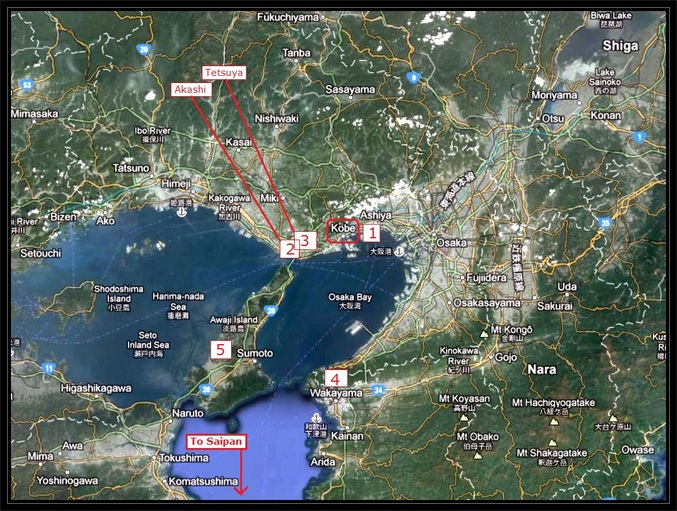
Image by Google Earth and customized by R. Slone
Map point #1-KOBE. The Fitzgerald crew was rammed by a Japanese fighter flown by Capt.Junichi Ogata over the city and exploded. The remains of both their aircraft and their bodies landed Northeast of the city in the
Hyogo-Ken POW Internment Camp. Nine men were KIA, and two parachuted away from the aircraft and were captured.
One of Capt.Ogata's boots was found in the fuselage
of the B-29, and the remains of his fighter aircraft were found near the POW camp.
Map point #2-AKASHI. The Christie crew (313th, Tinian) had evidently made their bomb run and the left turn to exit Kobe over Awaji-Shima. Reports state that their aircraft exploded over Akashi on Osaka Bay and there were no
survivors.
Map point #3-TETSUYA. The Shaffer crew (313th, Tinian) was hit by flak over the target and had an engine fire. According to Japanese reports they crashed into the sea just south of Tetsuya. There were no survivors.
Official mission reports state that crews reported seeing one B-29 under intense A/A fire going down in a flat spin over the target. We believe this was the Shaffer crew.
Map point#4-WAKAYAMA. The peninsula jutting out into the bay was the radar operators IP positioning point for the bomb run into Kobe.
Map point #5-AWAJI-SHIMA. After dropping their bombs, all B-29 crews were to make a left turn and exit the target area by flying over this island in the middle of Osaka Bay.
** We continue with our search for definitive proof of what happened to the two B-29s from Tinian, and any help would be greatly appreciated to solve the mystery of what aircraft the A Square 48 saw explode over target at Kobe.
